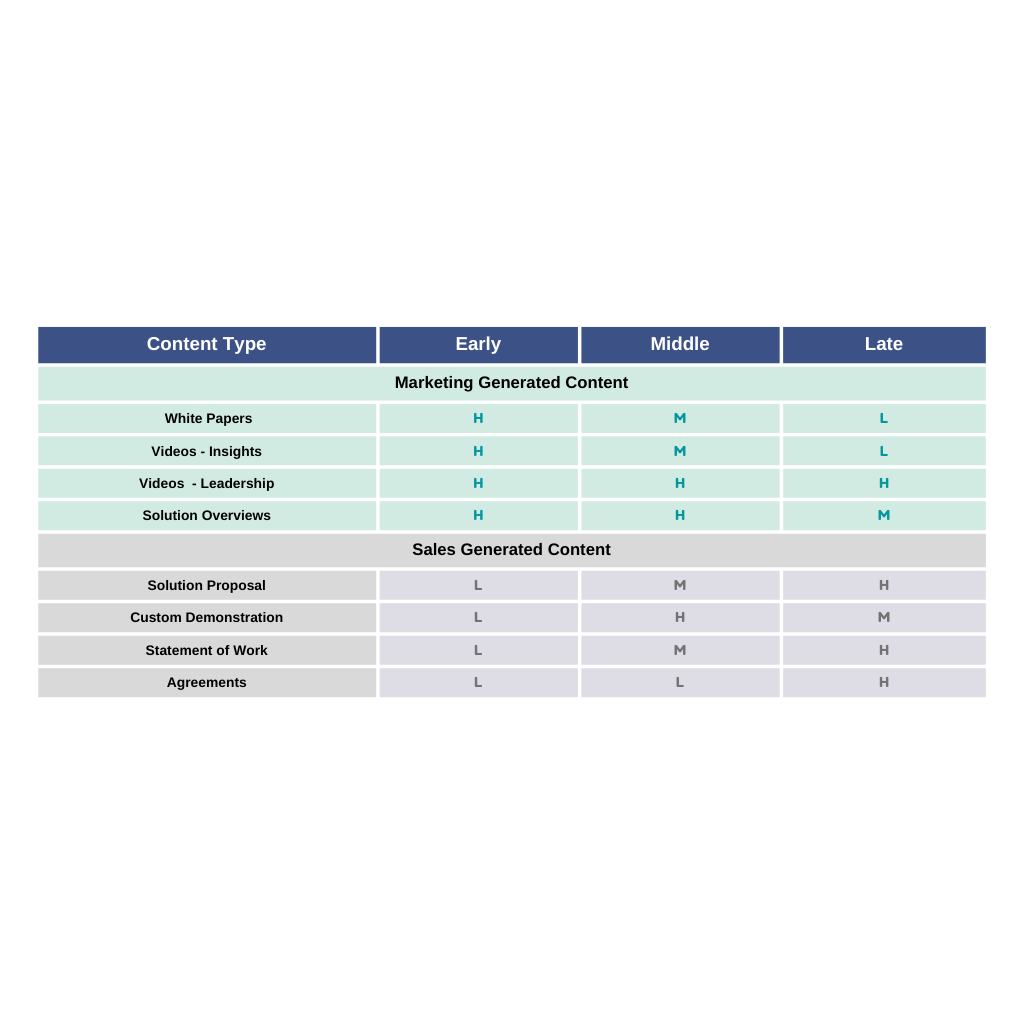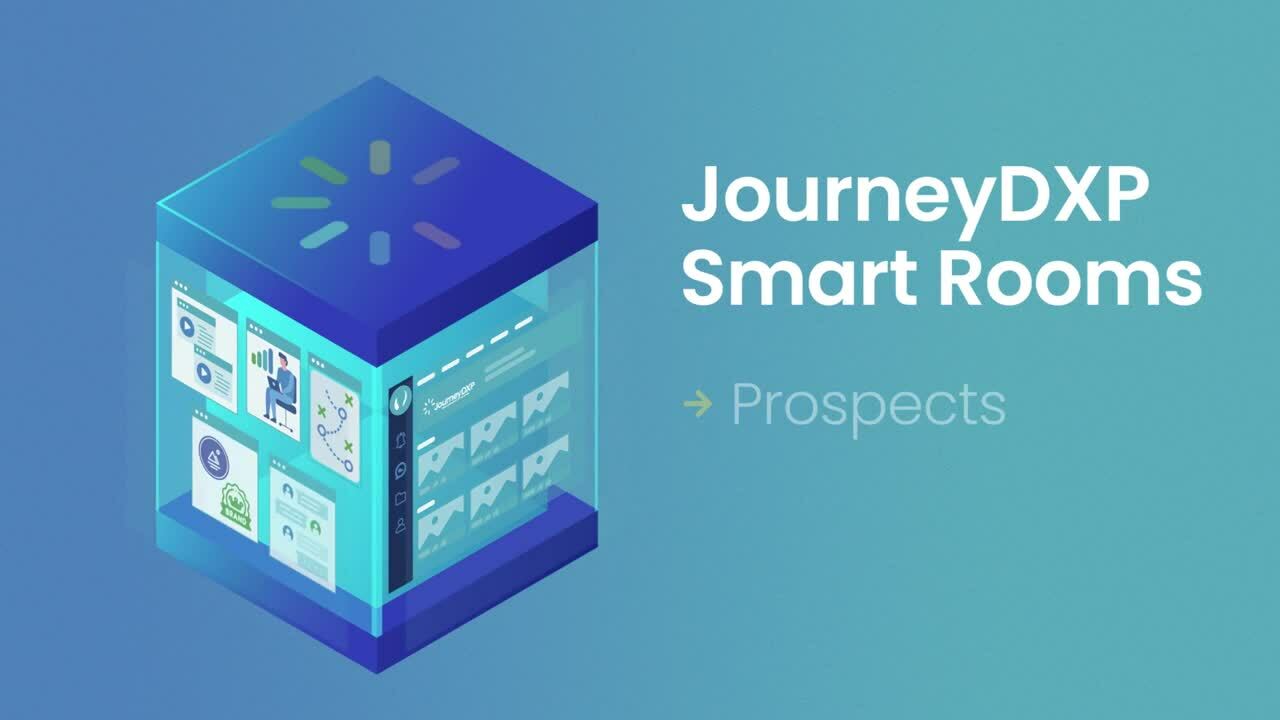Today, we live in a world of information overload. Helping buyers make sense of all the information is key to winning business. The best go-to-market strategies focus on making the buying process easier for customers, not just helping sellers sell.
B2B customers have evolved when it comes to content expectations, including availability and relevance, you need well-produced, high-value content that appeals to customers and encourages them through the buying journey. There is a myriad of content available today — both marketing and sales-generated. In general, content should be targeted towards specific stages in the buyers journey.
Content & The Customer Journey

An effective content strategy is about providing the right content, to the right people, at the right time. Customers shouldn’t have to jump through hoops to access your content. They expect a simple, easy to use, personalized experience which provides access to relevant content and the ability to collaborate with key people, all in one place.
An Integrated B2B Customer Experience
B2B customers want experiences much like their B2C counterparts. In fact, B2B companies now expect a seamless digital sales experience. Recent studies revealed that 70-80% of B2B decision-makers prefer digital self-service over traditional sales rep engagement.
Most companies have an abundance of content. Marketing generated content includes videos, demonstrations, product overviews, podcasts, presentations, whitepapers, and customer interviews. In addition, sales generated content includes solution proposals, statements of work, and ROI analysis.

Digital Sales Rooms (DSRs) are microsites designed to present an intuitive and engaging customer experience showcasing the best content to each buying group within a company (business, operations, technical, & finance). DSRs have emerged as one of the priority investments in the tech stack to engage customers and grow revenue.
Making it easier for customers to buy is one of the primary benefits of DSRs. Marketing and sales teams also benefit by:
Increasing Customer Engagement
DSRs provides an easy way for companies to engage more accounts and broaden relationships within each account. The best companies continue to engage even when the customer is not ready to buy. DSRs empower your customers to invite colleagues and extend reach across an account.
Better Execution
Companies can organize and present their best content and sales process in one convenient location. This improves efficiency for both the company and its customers and allows all buying groups to work in parallel, dramatically shortening sales cycles.
Digital Body Language
Customer analytics provide unprecedented insights into what’s working and what’s not. You can easily determine which buying groups are actively engaged and which groups require more time and attention.
Enhanced Security
Digital Sales rooms offer a secure and private environment to store documents, ensuring only authorized personnel have access. This ensures that sensitive information is kept safe and secure.
Content Strategy with DSRs
Creating a comprehensive and integrated B2B content strategy with digital sales rooms will help your business reach new levels of success. Begin with leveraging existing content today and using content analysis to develop a content roadmap that increases customer engagement.
Content Curation
Customers are not always right. In reality, customers are looking for guidance and the DSRs guide the customer through the optimal journey. Your marketing and sales teams understand what content and activity advance customers forward and the primary challenge is to resist the heavy-handed sales pitch too early.
Story Telling
Long-form content like white papers and case studies are relics of the 90s. Just like Netflix, B2B customers love a good story that creates an emotional connection. People still buy from people, and you can highlight videos of key influencers such as senior leaders, thought leaders, key presentations, solution demonstrations, and customer stories.
Digital Twin
DSRs are the digital twin for sales and account teams. Digital continues to sell when sales reps stop, and this automation increases sales rep productivity.
Smart Room Content Operations
Smart Rooms are the leading DSR in the market today. We’ve included our best practices from customers who successfully deployed Smart Rooms for marketing, sales, and account management use cases.
Organization
Alignment is critical as DSRs are jointly managed by marketing and sales. Many companies have merged marketing operations and sales enablement into a singular revenue operations team. Digital Centers of Excellence have emerged to ensure the best marketing and sales strategies are included.
Design
A Smart Room template helps to design the experience through the eyes of the customers. The design incorporates the buyer’s needs and your organization’s calls to action. Focus on quality over quantity and start with a narrow set of your best-performing content. Most templates include “hidden” complementary content that can easily be shared with the customer.
Personalization

Greater personalization leads to higher customer adoption. Each customer experience should be personalized including the customer’s brand colors, imagery, logo, and messaging. By understanding the customer’s needs we ensure the right content is wrapped around a positive customer experience.
Engagement
Digital Sales Rooms are designed to incorporate the human and digital. Digital experiences make the human better by doing the heavy lifting by consistently sharing key messages and content. Automation and ad hoc messaging provide for a complete engagement experience.
Analytics
DSR analytics provide unprecedented insights into people and content. The seller monitors activity and understands when the customer is ready to move forward. Engaging too early and the customer becomes more distant. Engage when the customer is ready and win rates dramatically improve.
Many B2B businesses have yet to develop a clear digital sales strategy. As a result, sales pipelines are degrading, and sales cycles are getting longer. If you want to succeed in today’s increasingly digital landscape, you need a digital selling strategy that works for you and your customers.
POPULAR
The Imperative Alignment of Sales and Marketing in the Digital Age
In today's hyperconnected and rapidly evolving business, communications, and technology landscape, the convergence of sales and marketing functions has become more pronounced than ever before. Alignment between sales and marketing teams has emerged as a critical determinant of success. This blog delves into why it has become more essential than ever for sales and marketing teams to be fully aligned in their prospect and customer engagement strategy and explores how digital sales rooms serve as potent tools in facilitating this alignment and fostering enhanced customer engagement.
RELATED
4 B2B Business Development Strategies Rooted In Thoughtfulness
Business development (and business development reps, also known as BDRs) get a bad rap. They’re traditionally viewed as the cold callers; the folks who chip away at a mountain of email addresses and phone numbers...




